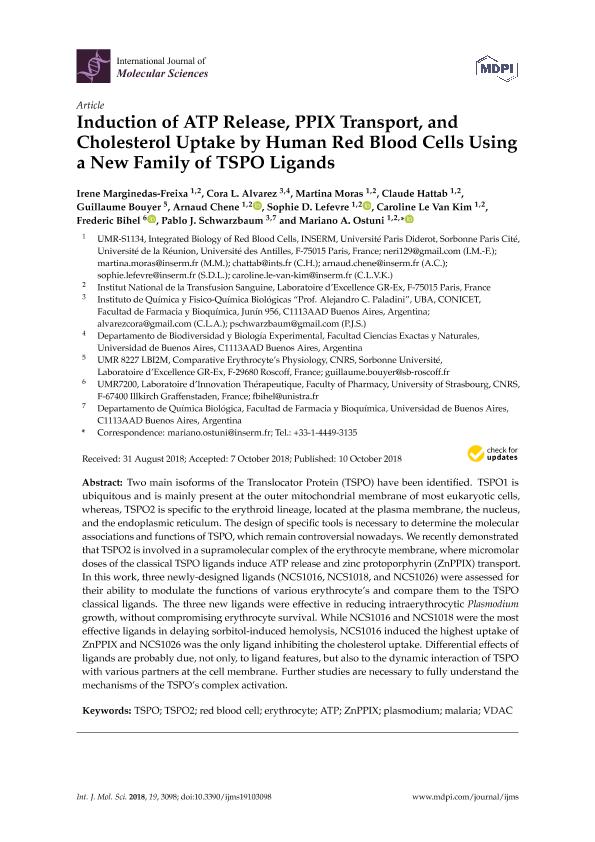Artículo
Induction of ATP Release, PPIX Transport, and Cholesterol Uptake by Human Red Blood Cells Using a New Family of TSPO Ligands
Marginedas-Freixa, Irene; Alvarez, Cora Lilia ; Moras, Martina; Hattab, Claude; Bouyer, Guillaume; Chene, Arnaud; Lefevre, Sophie D.; Le Van Kim, Caroline; Bihel, Frederic; Schwarzbaum, Pablo Julio
; Moras, Martina; Hattab, Claude; Bouyer, Guillaume; Chene, Arnaud; Lefevre, Sophie D.; Le Van Kim, Caroline; Bihel, Frederic; Schwarzbaum, Pablo Julio ; Ostuni, Mariano
; Ostuni, Mariano
 ; Moras, Martina; Hattab, Claude; Bouyer, Guillaume; Chene, Arnaud; Lefevre, Sophie D.; Le Van Kim, Caroline; Bihel, Frederic; Schwarzbaum, Pablo Julio
; Moras, Martina; Hattab, Claude; Bouyer, Guillaume; Chene, Arnaud; Lefevre, Sophie D.; Le Van Kim, Caroline; Bihel, Frederic; Schwarzbaum, Pablo Julio ; Ostuni, Mariano
; Ostuni, Mariano
Fecha de publicación:
10/2018
Editorial:
Molecular Diversity Preservation International
Revista:
International Journal of Molecular Sciences
ISSN:
1422-0067
Idioma:
Inglés
Tipo de recurso:
Artículo publicado
Clasificación temática:
Resumen
Two main isoforms of the Translocator Protein (TSPO) have been identified. TSPO1 isubiquitous and is mainly present at the outer mitochondrial membrane of most eukaryotic cells,whereas, TSPO2 is specific to the erythroid lineage, located at the plasma membrane, the nucleus,and the endoplasmic reticulum. The design of specific tools is necessary to determine the molecularassociations and functions of TSPO, which remain controversial nowadays. We recently demonstratedthat TSPO2 is involved in a supramolecular complex of the erythrocyte membrane, where micromolardoses of the classical TSPO ligands induce ATP release and zinc protoporphyrin (ZnPPIX) transport.In this work, three newly-designed ligands (NCS1016, NCS1018, and NCS1026) were assessed fortheir ability to modulate the functions of various erythrocyte?s and compare them to the TSPOclassical ligands. The three new ligands were effective in reducing intraerythrocytic Plasmodiumgrowth, without compromising erythrocyte survival. While NCS1016 and NCS1018 were the mosteffective ligands in delaying sorbitol-induced hemolysis, NCS1016 induced the highest uptake ofZnPPIX and NCS1026 was the only ligand inhibiting the cholesterol uptake. Differential effects ofligands are probably due, not only, to ligand features, but also to the dynamic interaction of TSPOwith various partners at the cell membrane. Further studies are necessary to fully understand themechanisms of the TSPO's complex activation.
Palabras clave:
TSPO
,
ANT
,
CHOLESTEROL
,
ATP RELEASE
Archivos asociados
Licencia
Identificadores
Colecciones
Articulos(IQUIFIB)
Articulos de INST.DE QUIMICA Y FISICO-QUIMICA BIOLOGICAS "PROF. ALEJANDRO C. PALADINI"
Articulos de INST.DE QUIMICA Y FISICO-QUIMICA BIOLOGICAS "PROF. ALEJANDRO C. PALADINI"
Citación
Marginedas-Freixa, Irene; Alvarez, Cora Lilia; Moras, Martina; Hattab, Claude; Bouyer, Guillaume; et al.; Induction of ATP Release, PPIX Transport, and Cholesterol Uptake by Human Red Blood Cells Using a New Family of TSPO Ligands; Molecular Diversity Preservation International; International Journal of Molecular Sciences; 19; 10; 10-2018
Compartir
Altmétricas



